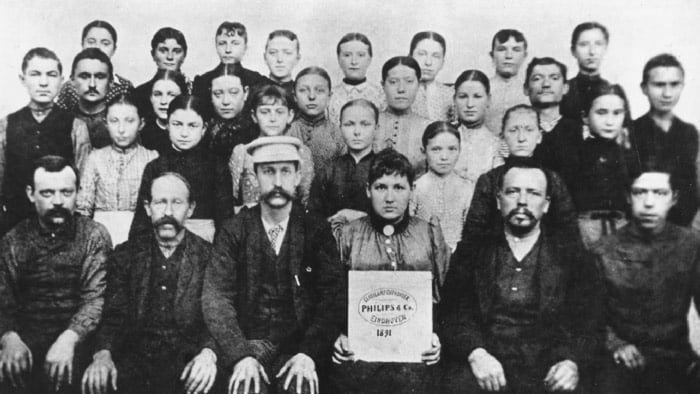When it comes to technological progress and innovation, few companies have made as profound an impact as Philips. With roots tracing back over a century, Philips has carved out an impressive legacy across industries ranging from lighting to healthcare. Let’s explore the company’s transformation from a small Dutch startup to a global health technology powerhouse. Uncover the advanced capabilities of the Philips 5500 LatteGo review
Modest Origins: The Birth of Philips
Philips was founded in 1891 by Gerard Philips and his father, Frederik Philips, in Eindhoven, Netherlands. Initially focused on manufacturing carbon-filament lamps, the company’s early years were characterized by financial struggles and fierce market competition. However, their unwavering commitment to quality laid the foundation for Philips to evolve into a global electronics leader. Get a closer look at the features of the Philips 5400 LatteGo review
Early Innovation Sparks Success
By the early 1900s, Philips had risen to become one of Europe's prominent light bulb manufacturers. This success was driven not just by large-scale production but also by a dedication to innovation. In 1914, Philips established its Research Laboratory (NatLab), which became a hotbed of creativity and technological advancement, propelling the company into new areas of growth. Compare these two machines side by side in the Philips LatteGo 5400 vs 4300 review
Expanding into Radio Technology
In the 1920s and 1930s, Philips ventured into the rapidly growing field of radio technology. The company started producing radios in 1927, recognizing the burgeoning interest in radio broadcasting. By 1932, they had sold over a million units, exemplifying their ability to tap into consumer demand with precision and foresight. Discover the differences among these models in the Philips 3200 vs 4300 vs 5400 review
Surviving World War II with Determination
World War II presented Philips with immense challenges, including disrupted operations and damaged facilities. Despite these adversities, the company showed extraordinary resilience. Key personnel were relocated, and vital research continued, allowing Philips to contribute to advancements in radar and other wartime technologies. Their ingenuity during this period exemplifies their adaptability. Learn how these two models compare in the Philips 3200 vs 4300 review

Post-War Growth: Introducing the Audio Cassette
After the war, Philips entered a new era of technological innovation. In 1963, they launched the compact audio cassette, revolutionizing how people recorded and listened to music. The audio cassette became a global phenomenon and cemented Philips’ position as a leader in consumer technology. See what sets these models apart in the Philips 3200 vs 5400 review
Transforming Music with the Compact Disc
In partnership with Sony, Philips launched the compact disc (CD) in the late 1970s, transforming the music industry with a durable, high-quality medium for digital audio. This achievement highlighted Philips’ ability to build global alliances and push technological boundaries that reshaped entertainment. Get a detailed review of the Philips LatteGo 5400 review
Diversification into Consumer Electronics and Television
Philips continued to diversify throughout the latter half of the 20th century, playing a major role in the development of the VHS format and later the DVD, redefining home entertainment. Their innovations, such as the Ambilight TV in the 1990s, further solidified their position as trailblazers in consumer electronics. Discover the compact and efficient design of the Philips 3200 LatteGo review
Leading the Charge in Healthcare Technology
In the 1980s, Philips began shifting focus towards healthcare technology, recognizing its vast potential. They invested in medical imaging, patient monitoring, and health informatics, eventually becoming a major player in the health tech industry. Strategic acquisitions and cutting-edge innovations helped Philips build a comprehensive portfolio dedicated to enhancing healthcare outcomes. Dive into the advanced features of the Philips 4300 LatteGo review
Focusing on Health and Lighting Solutions
In recent years, Philips has strategically realigned its focus, transitioning from traditional consumer electronics to health technology and lighting. In 2016, the company separated its lighting division, which rebranded as Signify, allowing Philips to concentrate more intensely on health technology. This move reflects the global trend towards prioritizing health and well-being.
Commitment to Sustainability and Corporate Responsibility
Philips has consistently demonstrated its dedication to sustainability and social responsibility. The company has set ambitious goals, such as achieving carbon-neutral operations and adopting circular economy principles, showcasing its commitment to environmentally responsible practices and improving societal well-being.
Embracing Digital Transformation
Philips has fully embraced the digital era by leveraging artificial intelligence (AI) and data analytics to enhance its products and services. With a focus on connected care and smart health solutions, Philips continues to establish itself as an innovative leader prepared for a future where technology plays a pivotal role in healthcare delivery and patient outcomes.

Conclusion: A Legacy of Innovation and Adaptability
The journey of Philips is a remarkable testament to the power of innovation and adaptability. From its beginnings in light bulb production to becoming a frontrunner in health technology, Philips has continually evolved to meet the changing needs of society. Their influence is seen across various industries, from revolutionizing how we enjoy music to pioneering advancements in healthcare.
As Philips continues to innovate and address global challenges, their legacy serves as an inspiring example of how dedication to technological progress and societal betterment can create a lasting impact. The future looks as promising as the rich history that has brought Philips to where it is today.
